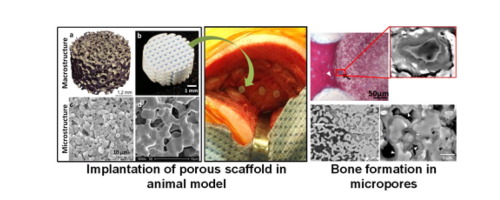当前位置:
X-MOL 学术
›
Acta Biomater.
›
论文详情
Our official English website, www.x-mol.net, welcomes your
feedback! (Note: you will need to create a separate account there.)
Mineralization in micropores of calcium phosphate scaffolds.
Acta Biomaterialia ( IF 9.4 ) Pub Date : 2018-11-05 , DOI: 10.1016/j.actbio.2018.11.003 Laurence E Rustom 1 , Michael J Poellmann 2 , Amy J Wagoner Johnson 3
Acta Biomaterialia ( IF 9.4 ) Pub Date : 2018-11-05 , DOI: 10.1016/j.actbio.2018.11.003 Laurence E Rustom 1 , Michael J Poellmann 2 , Amy J Wagoner Johnson 3
Affiliation

|
With the increasing demand for novel bone repair solutions that overcome the drawbacks of current grafting techniques, the design of artificial bone scaffolds is a central focus in bone regeneration research. Calcium phosphate scaffolds are interesting given their compositional similarity with bone mineral. The majority of studies focus on bone growth in the macropores (>100 µm) of implanted calcium phosphate scaffolds where bone structures such as osteons and trabeculae can form. However, a growing body of research shows that micropores (<50 µm) play an important role not only in improving bone growth in the macropores, but also in providing additional space for bone growth. Bone growth in the micropores of calcium phosphate scaffolds offers major mechanical advantages as it improves the mechanical properties of the otherwise brittle materials, further stabilizes the implant, improves load transfer, and generally enhances osteointegration. In this paper, we review evidence in the literature of bone growth into micropores, emphasizing on identification techniques and conditions under which bone components are observed in the micropores. We also review theories on mineralization and propose mechanisms, mediated by cells or not, by which mineralization may occur in the confined micropore space of calcium phosphate scaffolds. Understanding and validating these mechanisms will allow to better control and enhance mineralization in micropores to improve the design and efficiency of bone implants. STATEMENT OF SIGNIFICANCE: The design of synthetic bone scaffolds remains a major focus for engineering solutions to repair damaged and diseased bone. Most studies focus on the design of and growth in macropores (>100 µm), however research increasingly shows the importance of microporosity (<50 µm). Micropores provide an additional space for bone growth, which provides multiple mechanical advantages to the scaffold/bone composite. Here, we review evidence of bone growth into micropores in calcium phosphate scaffolds and conditions under which growth occurs in micropores, and we propose mechanisms that enable or facilitate growth in these pores. Understanding these mechanisms will allow researchers to exploit them and improve the design and efficiency of bone implants.
中文翻译:

磷酸钙支架微孔中的矿化作用。
随着对克服当前移植技术缺点的新型骨修复解决方案的需求不断增加,人造骨支架的设计已成为骨再生研究的重点。磷酸钙支架与骨矿物质的组成相似,因此很有趣。大多数研究集中在植入的磷酸钙支架的大孔(> 100 µm)中的骨骼生长,在这些骨骼中可以形成骨骼结构,例如骨质和小梁。但是,越来越多的研究表明,微孔(<50 µm)不仅在改善大孔中的骨骼生长方面,而且在为骨骼生长提供额外空间方面都起着重要作用。磷酸钙支架微孔中的骨生长提供了主要的机械优势,因为它改善了原本较脆的材料的机械性能,进一步稳定了植入物,改善了负荷转移,并总体上增强了骨整合。在本文中,我们重点回顾了骨骼生长为微孔的文献,重点介绍了在微孔中观察到骨成分的鉴定技术和条件。我们还回顾了有关矿化的理论,并提出了由细胞介导或不由细胞介导的机制,通过这种机制矿化可能会在磷酸钙支架的狭窄微孔空间中发生。了解和验证这些机制将有助于更好地控制和增强微孔中的矿化作用,从而改善骨植入物的设计和效率。重要性声明:合成骨支架的设计仍然是修复受损和患病骨骼的工程解决方案的主要重点。大多数研究集中在大孔(> 100 µm)的设计和生长上,但是研究越来越显示出微孔(<50 µm)的重要性。微孔为骨生长提供了额外的空间,这为支架/骨复合材料提供了多种机械优势。在这里,我们回顾了在磷酸钙支架中骨骼生长成微孔的证据以及在微孔中发生生长的条件,并提出了使这些孔能够生长或促进生长的机制。了解这些机制将使研究人员能够利用它们,并改善骨植入物的设计和效率。
更新日期:2018-11-06
中文翻译:

磷酸钙支架微孔中的矿化作用。
随着对克服当前移植技术缺点的新型骨修复解决方案的需求不断增加,人造骨支架的设计已成为骨再生研究的重点。磷酸钙支架与骨矿物质的组成相似,因此很有趣。大多数研究集中在植入的磷酸钙支架的大孔(> 100 µm)中的骨骼生长,在这些骨骼中可以形成骨骼结构,例如骨质和小梁。但是,越来越多的研究表明,微孔(<50 µm)不仅在改善大孔中的骨骼生长方面,而且在为骨骼生长提供额外空间方面都起着重要作用。磷酸钙支架微孔中的骨生长提供了主要的机械优势,因为它改善了原本较脆的材料的机械性能,进一步稳定了植入物,改善了负荷转移,并总体上增强了骨整合。在本文中,我们重点回顾了骨骼生长为微孔的文献,重点介绍了在微孔中观察到骨成分的鉴定技术和条件。我们还回顾了有关矿化的理论,并提出了由细胞介导或不由细胞介导的机制,通过这种机制矿化可能会在磷酸钙支架的狭窄微孔空间中发生。了解和验证这些机制将有助于更好地控制和增强微孔中的矿化作用,从而改善骨植入物的设计和效率。重要性声明:合成骨支架的设计仍然是修复受损和患病骨骼的工程解决方案的主要重点。大多数研究集中在大孔(> 100 µm)的设计和生长上,但是研究越来越显示出微孔(<50 µm)的重要性。微孔为骨生长提供了额外的空间,这为支架/骨复合材料提供了多种机械优势。在这里,我们回顾了在磷酸钙支架中骨骼生长成微孔的证据以及在微孔中发生生长的条件,并提出了使这些孔能够生长或促进生长的机制。了解这些机制将使研究人员能够利用它们,并改善骨植入物的设计和效率。











































 京公网安备 11010802027423号
京公网安备 11010802027423号